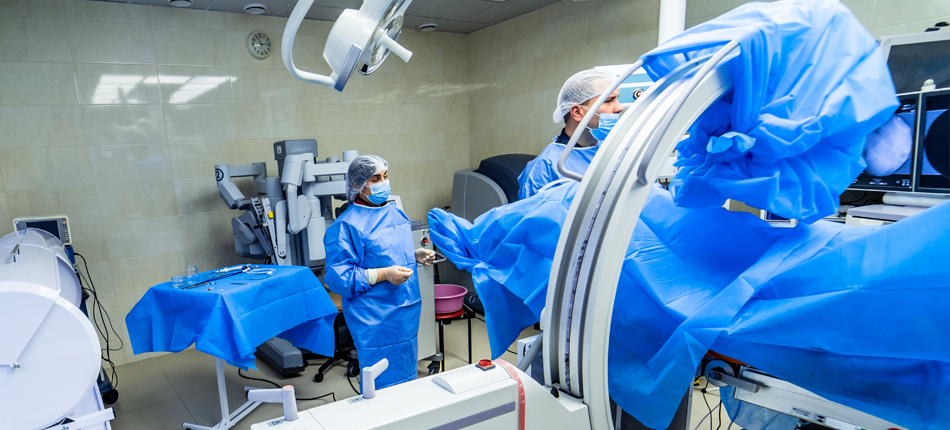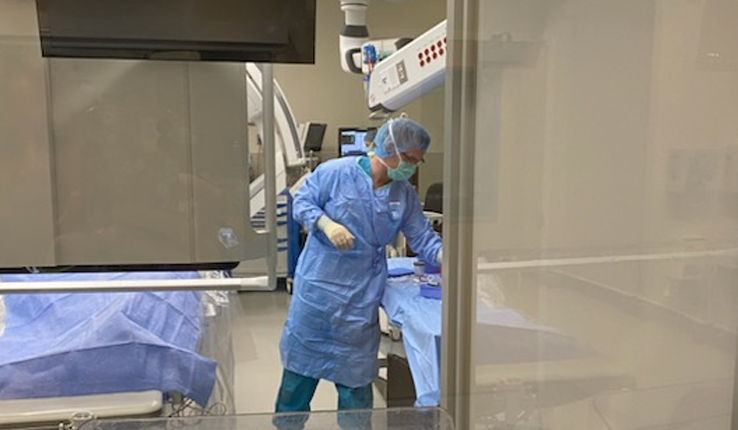Who We Are
Interventional Radiologists (IRs) are board-certified physicians with advanced training in diagnostic radiology, followed by additional training in vascular and interventional procedures. This comprehensive background in state-of-the art imaging techniques provides IRs the ability to quicky diagnose and treat medical conditions without the need for open surgery.
What We Do
Interventional Radiologists (IRs) use their expertise in fluoroscopy, CT, MRI and ultrasound to diagnose and treat intricate medical conditions. Working through an incision the size of a pinhole, IRs perform a variety of complex procedures in the arteries, veins, and nearly every organ in the human body.
Advantages of IR
- Convenience - most procedures can be performed on an outpatient basis or require only a short hospital stay
- Less risk – use of general anesthesia is not typically required
- Less pain due to small incisions
- Shortened recovery times
Procedures / Treatments
Genicular Artery Embolization (GAE)
GAE is also known as embolization of the knee, is a novel minimally-invasive procedure providing immediate and long term pain relief for patients with knee osteoarthritis (OA). GAE provides relief by dramatically reducing the blood flow to the lining of the knee.
Peripheral Arterial Disease (PAD)
PAD, diagnosed in the legs or lower extremities, is a circulatory condition that results in the narrowing or blockage of the vessels that carry blood from the heart to the legs. It is primarily caused by the buildup of fatty plaque in the arteries, which is called atherosclerosis.
Treatments for PAD
- Angioplasty: A tiny balloon is placed in the blood vessel at the site of the blockage. It is then inflated to open the blood vessel.
- Stents: A tiny metal cylinder, or stent, is inserted in the clogged vessel to act like a scaffolding and hold it open.
- Thrombolytic therapy: This treatment may be utilized if it is determined that the arterial blockage is caused by a blood clot. The most commonly used Thrombolytic drug called tPA is used to dissolve the clot and restore blood flow. The treatment is administered through a catheter directly into the clot. This treatment is most often used in combination with another intervention, such as angioplasty.
- Stent-grafts: A stent covered with synthetic fabric is inserted into the blood vessels to bypass diseased arteries.
Venus Disease
Venous disease is a common vascular disorder where there is high pressure buildup in the veins.Types of venous disease commonly treated by Intervetional Radiologists include:
- Blood clots: These can happen in your legs, arms, veins of your internal organs (kidney, spleen, intestines, liver and pelvic organs), in your brain (cerebral vein thrombosis), in your kidneys (renal vein thrombosis), or in your lungs (pulmonary embolism).
- Deep vein thrombosis (DVT): This is a blood clot that occurs in a deep vein (including arms and legs). Deep vein thrombosis itself isn’t life-threatening. However, the blood clot has the potential to break free and travel through the bloodstream, where it can stick in your lung’s blood vessels and become a pulmonary embolism. This can be a life-threatening condition.
- Superficial thrombophlebitis: This is a blood clot that develops in a vein close to the surface of your skin. These types of blood clots don’t usually travel to your lungs unless they move from your superficial system into your deep venous system first. Typically, however, they cause pain.
- Chronic venous insufficiency: This condition causes pooling of blood, chronic leg swelling, increased pressure, increased pigmentation or discoloration of your skin, and leg ulcers known as venous stasis ulcers.
- Varicose and spider veins: These are abnormal, dilated blood vessels that happen because of weakening in your blood vessel wall.
- Venous ulcers: Ulcers are wounds or open sores that won’t heal or keep returning. Venous stasis ulcers most commonly occur below your knee, on the inner part of your leg, just above your ankle.
- Arteriovenous fistulas: Highly abnormal, this is a condition wherein arteries and veins connect to each other directly, with nothing in between.
Thyroid Conditions
Several problems occur when your thyroid produces too much hormone (hyperthyroidism) or not enough (hypothyroidism). Interventional Radiology successfully treats most all thyroid disorders. Some of the most common thyroid-related conditions include
- Hyperthyroidism
- Hashimoto's Thyroiditis
- Thyroid Tumors
- Thyroid Cancer
- Thyroid Disorders in Women
- Postpartum Thyroiditis
Radiofrequency ablation (RFA) is a minimally invasive treatment option performed by interventional radiology that provides an alternative to surgery for some patients with thyroid nodules. The procedure involves inserting a small needle electrode into the thyroid nodule using ultrasound guidance. Heat generated at the tip of the needle works to destroy the target tissue.
Liver, Kidney and Colorectal Cancer
Hepatocellular carcinoma (HCC) Hepatocellular carcinoma (HCC) is a type of liver cancer. It starts in the main type of liver cell, called a hepatocyte.
Renal Cell Carcinoma (RCC) is the most common type of kidney cancer. RCC forms in tiny tubes inside your kidneys called tubules. The tubules direct water and nutrients to your bloodstream, while filtering waste through your urine. Up to 85% of kidney cancers are RCC.
Metastatic colorectal cancer is an advanced-stage malignancy that originated in the colon and has traveled to other areas of the body. This is also referred to as metastatic (stage IV) colorectal cancer.
Spinal Compression
Kyphoplasty is a minimally invasive procedure used to treat vertebral compression fractures. The procedure involves the injection of special cement into vertebrae — with the additional step of creating space for the treatment with a balloon-like device (balloon vertebroplasty). Kyphoplasty can restore a damaged vertebra's height and may also relieve pain.
Fibroid Tumors
Uterine Artery Embolization (UAE) is an embolization procedure of uterine arteries to stop life- threatening postpartum bleeding, potentially preventing hysterectomy.
Uterine Fibroid Embolization (UFE) is an embolization procedure of uterine arteries to shrink painful, enlarged, benign tumors in the uterus.
Our Team
The Interventional Radiology (IR) Division functions much like a surgical subspecialty team offering outpatient consultations, pre/post-visit coordination and inpatient care. We use the latest, cutting-edge technologies and our state-of-the-art facilities allow our team to perform the entire range of vascular and nonvascular procedures, treating adult and pediatric patients in Southern Arizona and beyond.




